seats CITROEN C-ELYSÉE 2022 Handbook (in English)
[x] Cancel search | Manufacturer: CITROEN, Model Year: 2022, Model line: C-ELYSÉE, Model: CITROEN C-ELYSÉE 2022Pages: 260, PDF Size: 8.4 MB
Page 4 of 260

2
.
.
Instrument Panel 8
W arning and indicator lamps 9
I
ndicators
19
Distance recorders
2
4
Setting the date and time
2
4
Trip computer
2
6Remote control
2
9
Alarm
32
Doors
33
Boot
34
Window controls
3
6
Front seats 3 7
Rear bench seat 3 9
Steering wheel adjustment 4
0
Mirrors
4
0
Heating
4
1
Manual air conditioning
(without display screen)
4
2
Electronic air conditioning
(with display screen)
4
4
Front demist – defrost
4
5
Rear screen demist – defrost
4
6
Fittings
4
8Lighting control
5
1
Direction indicators
5
3
Headlamp adjustment
5
4
Wiper control stalk
5
4
Courtesy lamps
5
5
General safety recommendations
5
7
Hazard warning lamps
5
8
Horn 58
Emergency or assistance call 5 8
Electronic stability control (ESC)
6
0
Seat belts
6
2
Airbags
65
Child seats
6
8
Deactivating the passenger's front airbag
7
0
ISOFIX mountings
7
5
Child lock
7
9
Over view
Instruments Access
Ease of use and comfort Safety
Lighting and visibility
Eco-driving
Eco-driving 6
Contents
Page 9 of 260
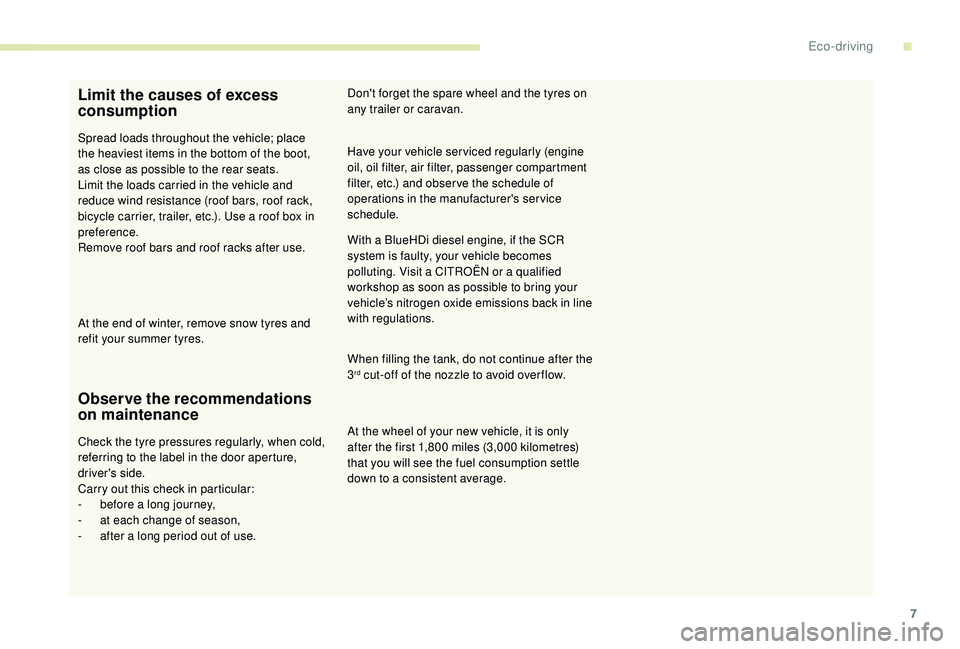
7
Limit the causes of excess
consumption
Spread loads throughout the vehicle; place
the heaviest items in the bottom of the boot,
as close as possible to the rear seats.
Limit the loads carried in the vehicle and
reduce wind resistance (roof bars, roof rack,
bicycle carrier, trailer, etc.). Use a roof box in
preference.
Remove roof bars and roof racks after use.
At the end of winter, remove snow tyres and
refit your summer tyres.
Observe the recommendations
on maintenance
Check the tyre pressures regularly, when cold,
referring to the label in the door aperture,
driver's side.
Carry out this check in particular:
-
b
efore a long journey,
-
a
t each change of season,
-
a
fter a long period out of use. Have your vehicle ser viced regularly (engine
oil, oil filter, air filter, passenger compartment
filter, etc.) and obser ve the schedule of
operations in the manufacturer's service
schedule. Don't forget the spare wheel and the tyres on
any trailer or caravan.
With a BlueHDi diesel engine, if the SCR
system is faulty, your vehicle becomes
polluting. Visit a CITROËN or a qualified
workshop as soon as possible to bring your
vehicle’s nitrogen oxide emissions back in line
with regulations.
When filling the tank, do not continue after the
3
rd cut-off of the nozzle to avoid over flow.
At the wheel of your new vehicle, it is only
after the first 1,800
miles (3,000 kilometres)
that you will see the fuel consumption settle
down to a consistent average.
.
Eco-driving
Page 36 of 260
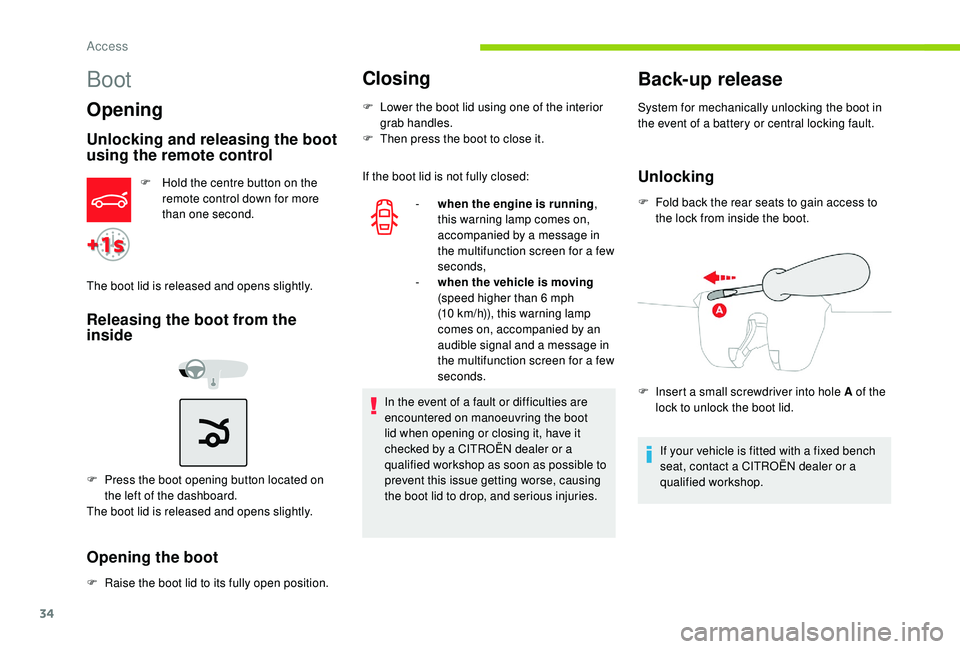
34
Boot
Opening
Unlocking and releasing the boot
using the remote control
F Hold the centre button on the remote control down for more
than one second.
The boot lid is released and opens slightly.
Releasing the boot from the
inside
F Press the boot opening button located on the left of the dashboard.
The boot lid is released and opens slightly.
Opening the boot
F Raise the boot lid to its fully open position.
Closing
F Lower the boot lid using one of the interior grab handles.
F
T
hen press the boot to close it.
-
w
hen the engine is running ,
this warning lamp comes on,
accompanied by a message in
the multifunction screen for a few
seconds,
-
w
hen the vehicle is moving
(speed higher than 6
mph
(10
km/h)), this warning lamp
comes on, accompanied by an
audible signal and a message in
the multifunction screen for a few
seconds.
Back-up release
System for mechanically unlocking the boot in
the event of a battery or central locking fault.
UnlockingIf the boot lid is not fully closed:
F
F
old back the rear seats to gain access to
the lock from inside the boot.
If your vehicle is fitted with a fixed bench
seat, contact a CITROËN dealer or a
qualified workshop.
F
I
nsert a small screwdriver into hole A of the
lock to unlock the boot lid.
In the event of a fault or difficulties are
encountered on manoeuvring the boot
lid when opening or closing it, have it
checked by a CITROËN dealer or a
qualified workshop as soon as possible to
prevent this issue getting worse, causing
the boot lid to drop, and serious injuries.
Access
Page 39 of 260
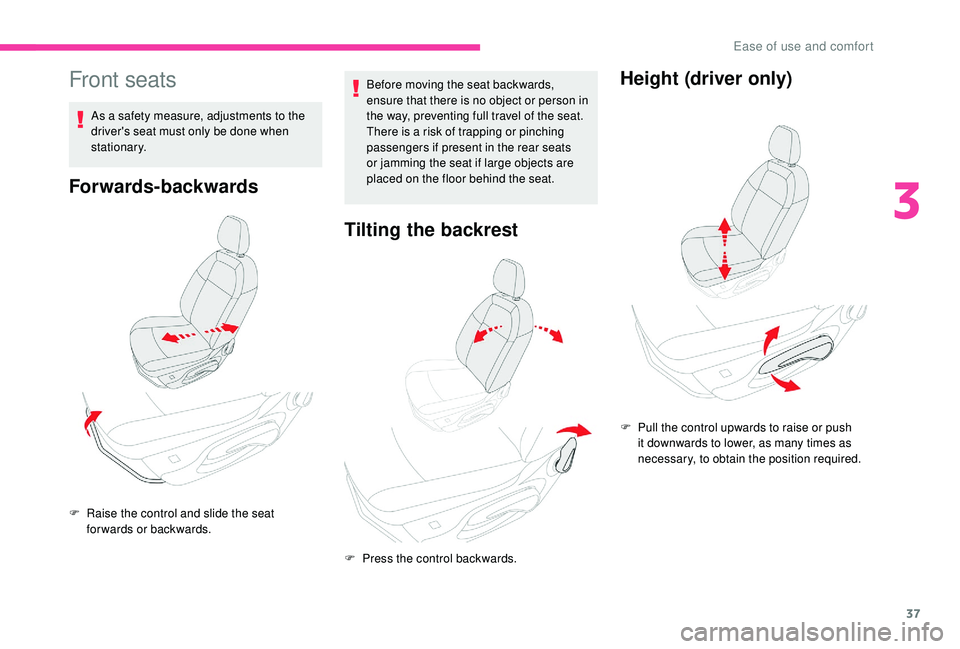
37
Front seats
As a safety measure, adjustments to the
driver's seat must only be done when
stationary.
Forwards-backwards
Before moving the seat backwards,
ensure that there is no object or person in
the way, preventing full travel of the seat.
There is a risk of trapping or pinching
passengers if present in the rear seats
or jamming the seat if large objects are
placed on the floor behind the seat.
Tilting the backrest
F Raise the control and slide the seat forwards or backwards.
F
P
ress the control backwards.
Height (driver only)
F Pull the control upwards to raise or push it downwards to lower, as many times as
necessary, to obtain the position required.
3
Ease of use and comfort
Page 40 of 260
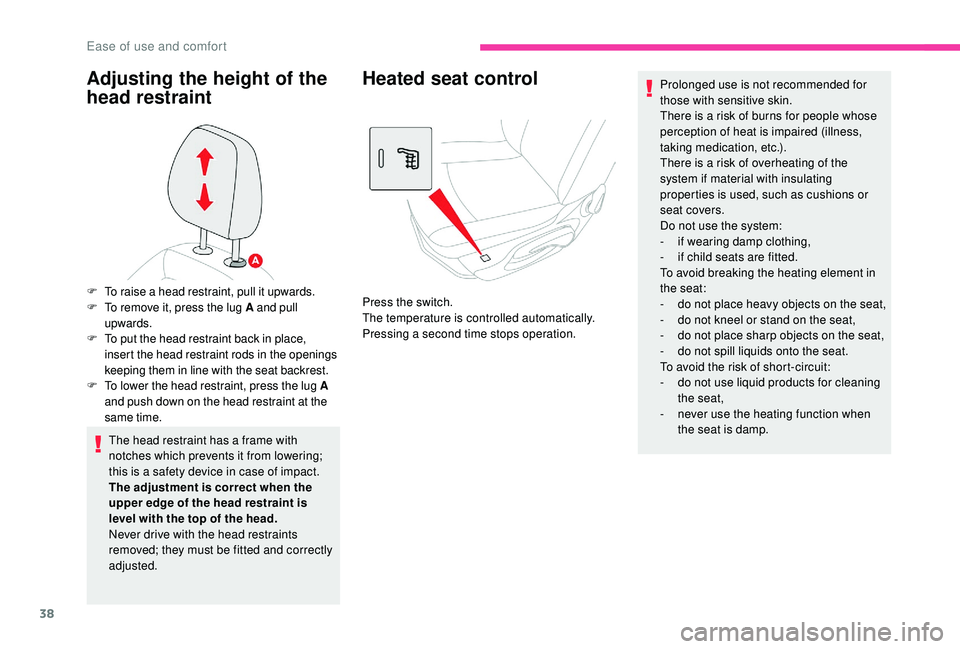
38
Adjusting the height of the
head restraint
The head restraint has a frame with
notches which prevents it from lowering;
this is a safety device in case of impact.
The adjustment is correct when the
upper edge of the head restraint is
level with the top of the head.
Never drive with the head restraints
removed; they must be fitted and correctly
adjusted.
Heated seat controlProlonged use is not recommended for
those with sensitive skin.
There is a risk of burns for people whose
perception of heat is impaired (illness,
taking medication, etc.).
There is a risk of overheating of the
system if material with insulating
properties is used, such as cushions or
seat covers.
Do not use the system:
-
i
f wearing damp clothing,
-
i
f child seats are fitted.
To avoid breaking the heating element in
the seat:
-
d
o not place heavy objects on the seat,
-
d
o not kneel or stand on the seat,
-
d
o not place sharp objects on the seat,
-
d
o not spill liquids onto the seat.
To avoid the risk of short-circuit:
-
d
o not use liquid products for cleaning
the seat,
-
n
ever use the heating function when
the seat is damp.
F
T
o raise a head restraint, pull it upwards.
F
T
o remove it, press the lug A and pull
upwards.
F
T
o put the head restraint back in place,
insert the head restraint rods in the openings
keeping them in line with the seat backrest.
F
T
o lower the head restraint, press the lug A
and push down on the head restraint at the
same time. Press the switch.
The temperature is controlled automatically.
Pressing a second time stops operation.
Ease of use and comfort
Page 41 of 260
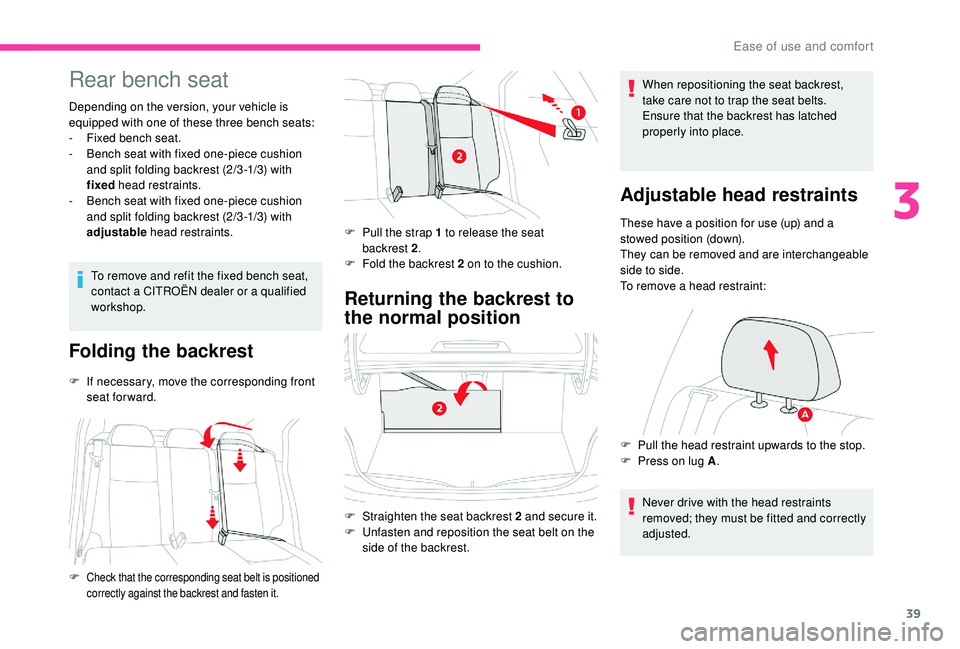
39
Rear bench seat
Depending on the version, your vehicle is
equipped with one of these three bench seats:
-
F
ixed bench seat.
-
B
ench seat with fixed one-piece cushion
and split folding backrest (2/3 -1/3) with
fixed head restraints.
-
B
ench seat with fixed one-piece cushion
and split folding backrest (2/3 -1/3) with
adjustable head restraints.
To remove and refit the fixed bench seat,
contact a CITROËN dealer or a qualified
workshop.
Folding the backrest
F If necessary, move the corresponding front seat forward.
Returning the backrest to
the normal position
When repositioning the seat backrest,
take care not to trap the seat belts.
Ensure that the backrest has latched
properly into place.
Adjustable head restraints
These have a position for use (up) and a
stowed position (down).
They can be removed and are interchangeable
side to side.
To remove a head restraint:
Never drive with the head restraints
removed; they must be fitted and correctly
adjusted.
F
P
ull the head restraint upwards to the stop.
F
P
ress on lug A .
F
S
traighten the seat backrest 2
and secure it.
F
U
nfasten and reposition the seat belt on the
side of the backrest.
F
Check that the corresponding seat belt is positioned correctly against the backrest and fasten it.
F Pull the strap 1 to release the seat
backrest 2 .
F
F
old the backrest 2 on to the cushion.
3
Ease of use and comfort
Page 56 of 260
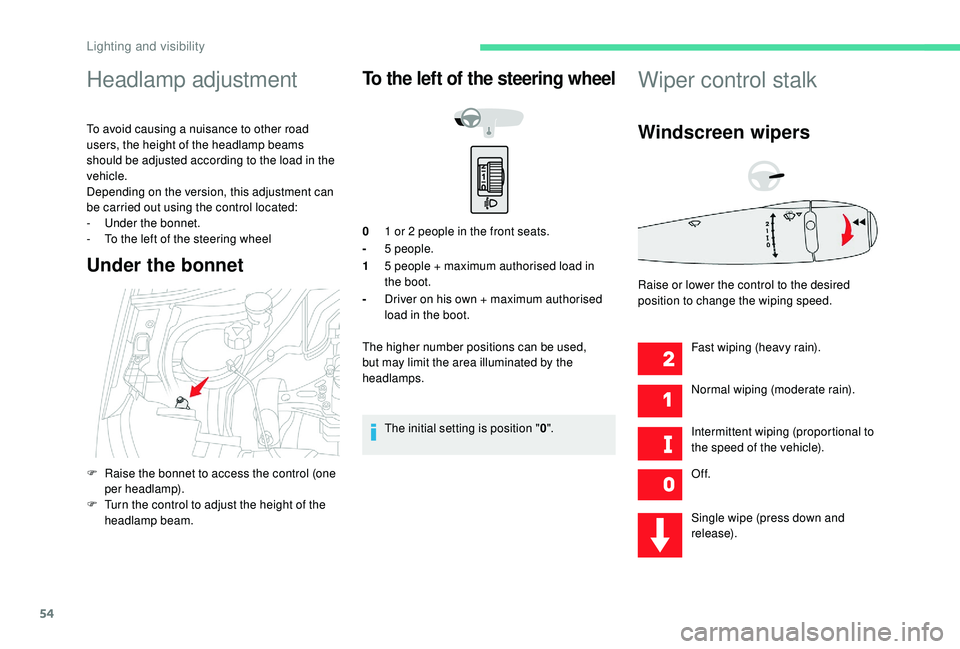
54
Headlamp adjustment
To avoid causing a nuisance to other road
users, the height of the headlamp beams
should be adjusted according to the load in the
vehicle.
Depending on the version, this adjustment can
be carried out using the control located:
-
U
nder the bonnet.
-
T
o the left of the steering wheel
Under the bonnet
To the left of the steering wheel
01 or 2 people in the front seats.
- 5
people.
1 5
people + maximum authorised load in
the boot.
- Driver on his own + maximum authorised
load in the boot.
The higher number positions can be used,
but may limit the area illuminated by the
headlamps.
The initial setting is position " 0".
Wiper control stalk
Windscreen wipers
Fast wiping (heavy rain).
Normal wiping (moderate rain).
Intermittent wiping (proportional to
the speed of the vehicle).
Of f.
Single wipe (press down and
release).
F
R
aise the bonnet to access the control (one
per headlamp).
F
T
urn the control to adjust the height of the
headlamp beam. Raise or lower the control to the desired
position to change the wiping speed.
Lighting and visibility
Page 64 of 260
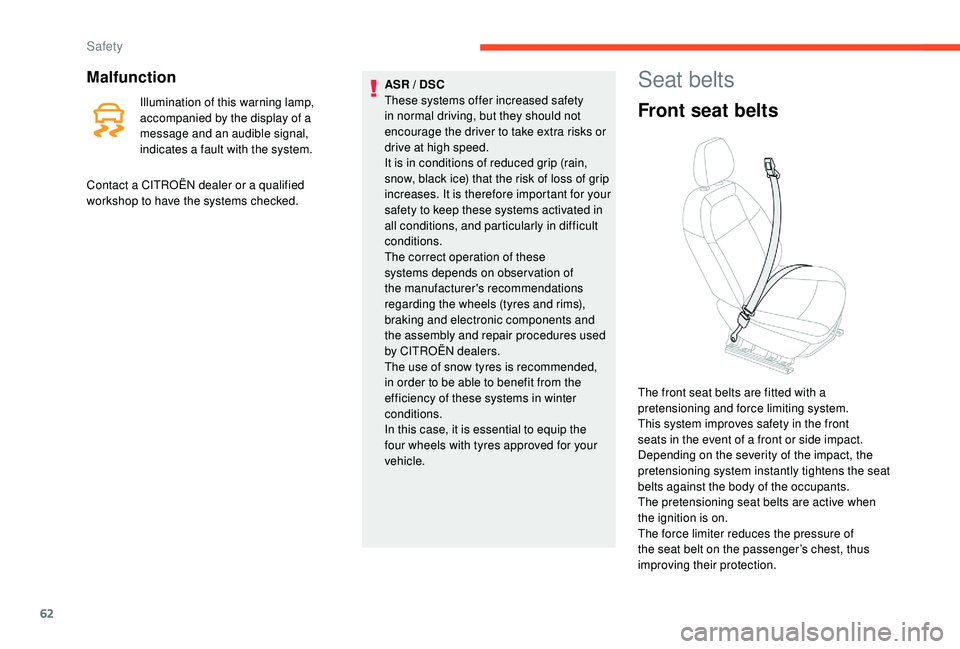
62
Malfunction
Illumination of this warning lamp,
accompanied by the display of a
message and an audible signal,
indicates a fault with the system.ASR / DSC
These systems offer increased safety
in normal driving, but they should not
encourage the driver to take extra risks or
drive at high speed.
It is in conditions of reduced grip (rain,
snow, black ice) that the risk of loss of grip
increases. It is therefore important for your
safety to keep these systems activated in
all conditions, and particularly in difficult
conditions.
The correct operation of these
systems depends on obser vation of
the manufacturer's recommendations
regarding the wheels (tyres and rims),
braking and electronic components and
the assembly and repair procedures used
by CITROËN dealers.
The use of snow tyres is recommended,
in order to be able to benefit from the
efficiency of these systems in winter
conditions.
In this case, it is essential to equip the
four wheels with tyres approved for your
vehicle.
Seat belts
Front seat belts
The front seat belts are fitted with a
pretensioning and force limiting system.
This system improves safety in the front
seats in the event of a front or side impact.
Depending on the severity of the impact, the
pretensioning system instantly tightens the seat
belts against the body of the occupants.
The pretensioning seat belts are active when
the ignition is on.
The force limiter reduces the pressure of
the seat belt on the passenger’s chest, thus
improving their protection.
Contact a CITROËN dealer or a qualified
workshop to have the systems checked.
Safety
Page 65 of 260
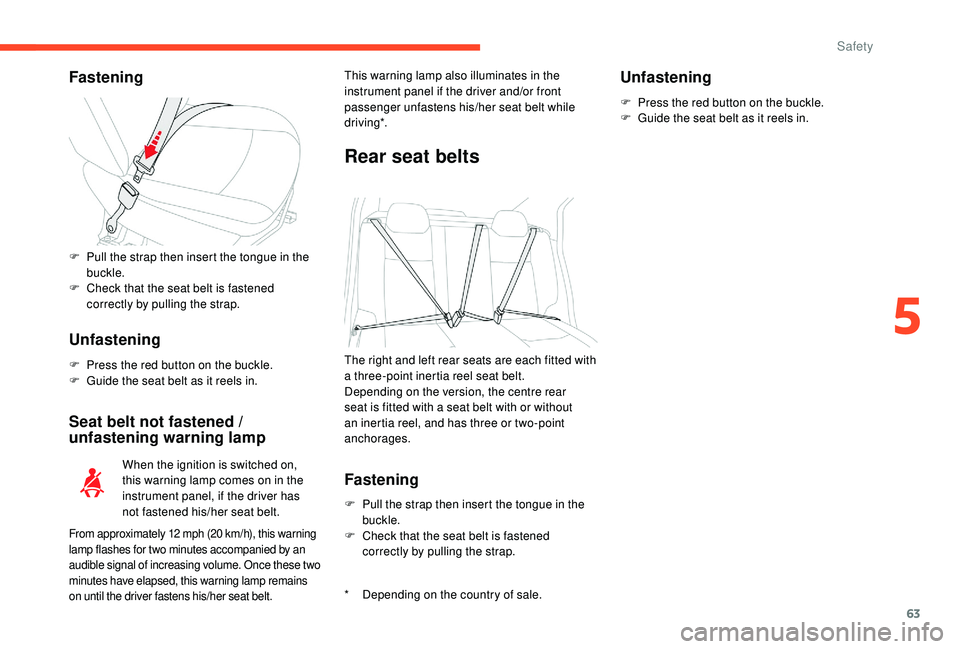
63
Fastening
Unfastening
F Press the red button on the buckle.
F G uide the seat belt as it reels in.
Seat belt not fastened /
unfastening warning lamp
* Depending on the country of sale.
F
P
ull the strap then insert the tongue in the
buckle.
F
C
heck that the seat belt is fastened
correctly by pulling the strap. This warning lamp also illuminates in the
instrument panel if the driver and/or front
passenger unfastens his/her seat belt while
driving*.
When the ignition is switched on,
this warning lamp comes on in the
instrument panel, if the driver has
not fastened his/her seat belt.
From approximately 12 mph (20 km/h), this warning
lam p flashes for two minutes accompanied by an
audible signal of increasing volume. Once these two
minutes have elapsed, this warning lamp remains
on until the driver fastens his/her seat belt.
Rear seat belts
Fastening
F Pull the strap then insert the tongue in the buckle.
F
C
heck that the seat belt is fastened
correctly by pulling the strap.
Unfastening
F Press the red button on the buckle.
F G uide the seat belt as it reels in.
The right and left rear seats are each fitted with
a three-point inertia reel seat belt.
Depending on the version, the centre rear
seat is fitted with a seat belt with or without
an inertia reel, and has three or two-point
anchorages.
5
Safety
Page 66 of 260
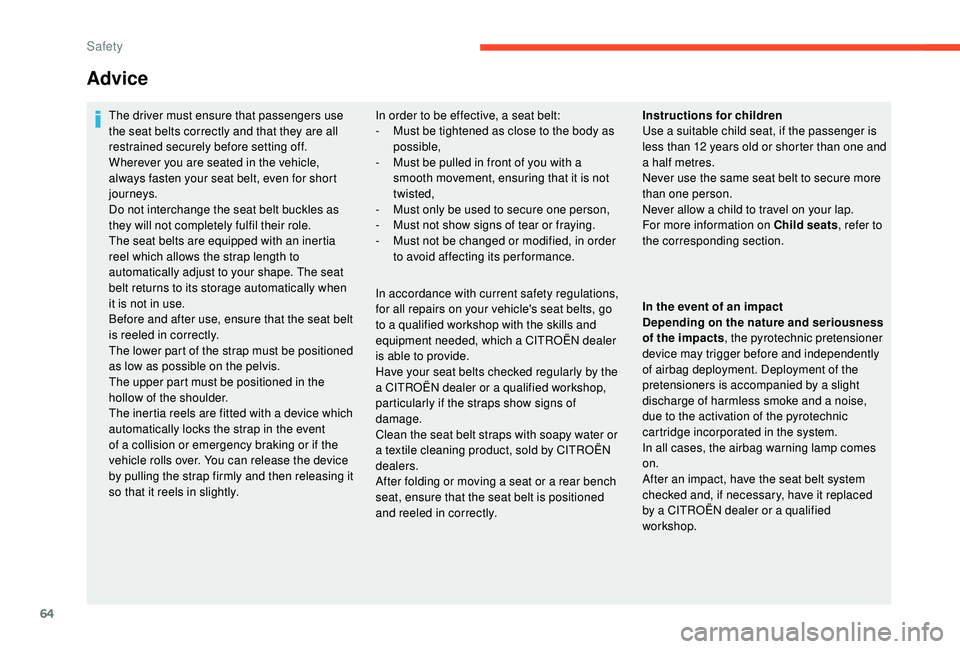
64
Advice
The driver must ensure that passengers use
the seat belts correctly and that they are all
restrained securely before setting off.
Wherever you are seated in the vehicle,
always fasten your seat belt, even for short
journeys.
Do not interchange the seat belt buckles as
they will not completely fulfil their role.
The seat belts are equipped with an inertia
reel which allows the strap length to
automatically adjust to your shape. The seat
belt returns to its storage automatically when
it is not in use.
Before and after use, ensure that the seat belt
is reeled in correctly.
The lower part of the strap must be positioned
as low as possible on the pelvis.
The upper part must be positioned in the
hollow of the shoulder.
The inertia reels are fitted with a device which
automatically locks the strap in the event
of a collision or emergency braking or if the
vehicle rolls over. You can release the device
by pulling the strap firmly and then releasing it
so that it reels in slightly.In order to be effective, a seat belt:
-
M ust be tightened as close to the body as
possible,
-
M
ust be pulled in front of you with a
smooth movement, ensuring that it is not
twisted,
-
M
ust only be used to secure one person,
-
M
ust not show signs of tear or fraying.
-
M
ust not be changed or modified, in order
to avoid affecting its performance. Instructions for children
Use a suitable child seat, if the passenger is
less than 12
years old or shorter than one and
a half metres.
Never use the same seat belt to secure more
than one person.
Never allow a child to travel on your lap.
For more information on Child seats , refer to
the corresponding section.
In accordance with current safety regulations,
for all repairs on your vehicle's seat belts, go
to a qualified workshop with the skills and
equipment needed, which a CITROËN dealer
is able to provide.
Have your seat belts checked regularly by the
a CITROËN dealer or a qualified workshop,
particularly if the straps show signs of
damage.
Clean the seat belt straps with soapy water or
a textile cleaning product, sold by CITROËN
dealers.
After folding or moving a seat or a rear bench
seat, ensure that the seat belt is positioned
and reeled in correctly. In the event of an impact
Depending on the nature and seriousness
of the impacts
, the pyrotechnic pretensioner
device may trigger before and independently
of airbag deployment. Deployment of the
pretensioners is accompanied by a slight
discharge of harmless smoke and a noise,
due to the activation of the pyrotechnic
cartridge incorporated in the system.
In all cases, the airbag warning lamp comes
on.
After an impact, have the seat belt system
checked and, if necessary, have it replaced
by a CITROËN dealer or a qualified
workshop.
Safety